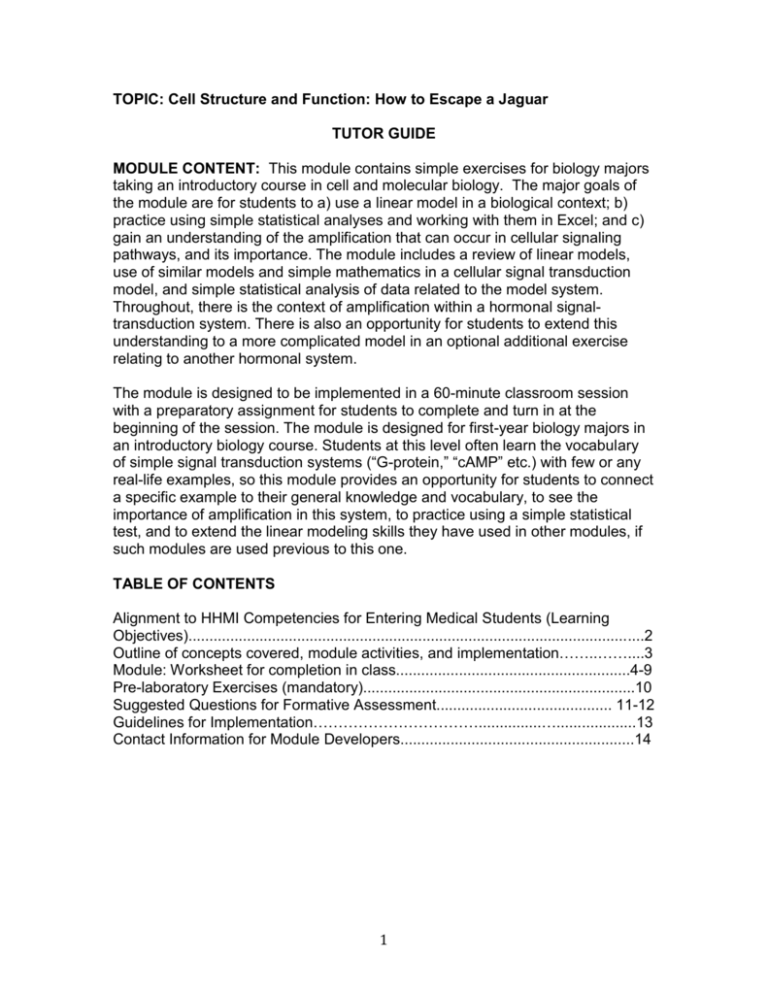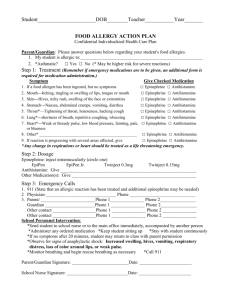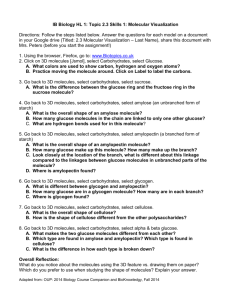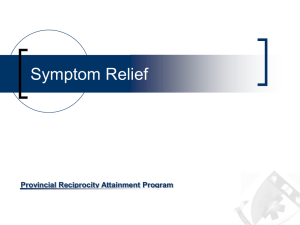Cell Structure and Function Module (*Why You
advertisement

TOPIC: Cell Structure and Function: How to Escape a Jaguar TUTOR GUIDE MODULE CONTENT: This module contains simple exercises for biology majors taking an introductory course in cell and molecular biology. The major goals of the module are for students to a) use a linear model in a biological context; b) practice using simple statistical analyses and working with them in Excel; and c) gain an understanding of the amplification that can occur in cellular signaling pathways, and its importance. The module includes a review of linear models, use of similar models and simple mathematics in a cellular signal transduction model, and simple statistical analysis of data related to the model system. Throughout, there is the context of amplification within a hormonal signaltransduction system. There is also an opportunity for students to extend this understanding to a more complicated model in an optional additional exercise relating to another hormonal system. The module is designed to be implemented in a 60-minute classroom session with a preparatory assignment for students to complete and turn in at the beginning of the session. The module is designed for first-year biology majors in an introductory biology course. Students at this level often learn the vocabulary of simple signal transduction systems (“G-protein,” “cAMP” etc.) with few or any real-life examples, so this module provides an opportunity for students to connect a specific example to their general knowledge and vocabulary, to see the importance of amplification in this system, to practice using a simple statistical test, and to extend the linear modeling skills they have used in other modules, if such modules are used previous to this one. TABLE OF CONTENTS Alignment to HHMI Competencies for Entering Medical Students (Learning Objectives).............................................................................................................2 Outline of concepts covered, module activities, and implementation……..……....3 Module: Worksheet for completion in class........................................................4-9 Pre-laboratory Exercises (mandatory).................................................................10 Suggested Questions for Formative Assessment.......................................... 11-12 Guidelines for Implementation……………………………...............…...................13 Contact Information for Module Developers........................................................14 1 Alignment to HHMI Competencies for Entering Medical Students: Competency E1. Apply quantitative reasoning and appropriate mathematics to describe or explain phenomena in the natural world. E7: Explain how organisms sense and control their internal environment and how they respond to external change. Learning Objective E1.1 Demonstrate quantitative numeracy and facility with the language of mathematics Activity 1,2 E1.2. Interpret data sets and communicate those interpretations using visual and other appropriate tools. E1.3. Make statistical inferences from data sets (evaluating best fit linear relationships based on calculating error sums of squares) E1.5. Make inferences about natural phenomena using mathematical models E1.7 Quantify and interpret changes in dynamical systems. 3,4,5,6 E7.2 Explain physical and chemical mechanisms used for transduction and information processing in the sensing and integration of internal and environmental signals 1,4,5 2 6 5,6 5 Mathematical Concepts covered: - power functions - linear models - t-tests In class activities: - group discussion - graphing in Excel and interpreting data - construction of linear models - carrying out t-tests in Excel Components of module: - preparatory assignment to complete and turn in as homework before class - in class worksheet: - discussion questions - plotting and interpreting data - suggested assessment questions - guidelines for implementation Estimated time to complete in class worksheet - 60 minutes Targeted students: - first year-biology majors in introductory biology course Quantitative Skills Required: - Basic arithmetic - Logical reasoning - Interpreting data from tables - Graph/Data Interpretation 3 WORKSHEET: Cell structure and function In Class Exercises Background When your body needs to respond to an acute stressor, such as a jaguar coming into the room, the sympathetic nervous system triggers an immediate release of the hormone epinephrine, also known as adrenaline. Epinephrine travels in the bloodstream to the liver, where it attaches to specific proteins (receptors) on liver cell membranes and stimulates those cells to break down glycogen into glucose and release the glucose into the bloodstream, providing a source of energy for you to run away from the jaguar. 4 Epinephrine Receptor Adenylate cyclase G-protein Inactive cAMP-dept. protein kinase Active cAMPdept. protein kinase Inactive glycogen phosphorylase kinase Active glycogen phosphorylase kinase Inactive glycogen phosphorylase Active gly phosphor Glycogen As you can see, this process involves several steps and most of these steps involve activation of an enzyme (anything ending in “-ase”!). Recall that enzymes are not consumed in the reaction they catalzye, so in this case the binding of one epinephrine molecule to its receptor on the liver cell can result in many glucose molecules being released. 5 6 Questions 1. Let’s assume that one molecule of epinephrine binding to the cell activates one G-protein, which activates one adenylate cyclase. From there, assume that every enzyme catalyzes 10 reactions (for example, each activated adenlylate cyclase produces 10 molecules of activated cAMP dependent protein kinase). Finally, assume that each activated glycogen phosphorylase “frees” 10 molecules of glucose to be released from the cell into the bloodstream. Given that, how many molecules of glucose are released into the blood for each molecule of epinephrine that binds? 2. Consider that the epinephrine is only present when you see the jaguar, so prior to that there is no epinephrine to bind. After the epinephrine is in the bloodstream, the number of bound epinephrine reaches a maximum when all the receptors are full. Suppose that there are 100 epinephrine receptors on the cell. Using the ideas of piece-wise linear functions that you developed in the homework for this module, write an equation for the amount of glucose as a function of the amount of bound epinephrine. 3. With “number of molecules of epinephrine bound” on the X axis and “number of molecules of glucose released” on the Y axis, plot the relationship between these variables, as described by your answer to part 1. 4. Using your graph, explain what biological features of this system dictate the piecewise linear structure of the graph. Use phrases like “floor” and “ceiling,” and justify them in the context of the biological system. 5. Now, consider the rate of bloodflow to the muscles both before and after the jaguar sighting. This is important because the more blood your muscles get, the more glucose they get, and the faster you can run away! Now suppose that the veins and arteries are modeled as tubes with constant radius. The bloodflow is directly proportional to the radius to the fourth power. a. Write an equation for the bloodflow as a function of radius. Plot the bloodflow as a function of radius (remember that the radius is on the x-axis and the bloodflow is on the y-axis) b. On the same plot, add the graphs of the functions e^x and x^2. Which graph goes to up faster as x gets large? Which graph goes to up slowest when x gets large? Do you think that x^5 goes up faster or slower than x^4? 7 c. If the arteries going to your muscles get twice as wide during a jaguar sighting (they do!), how much more blood flows through them (by what factor does blood flow increase)? 6. As part of a study, 10 mg of epinephrine was injected into the bloodstream of 10 resting, fasted adults. 10 minutes later, blood glucose levels of the subjects were measured. Here were the results: Subject Sex Age 1 2 3 4 5 6 7 8 9 10 F F F F F M M M M M 25 36 61 54 39 43 46 31 51 37 Blood Glucose Level, mg/dL 197 175 231 217 205 251 234 181 197 161 Using Excel and the above data, perform a t-test to answer the questions: a) Did the men have a significantly different glucose level after epinephrine injection than the women? b) Did the individuals over 40 have a significantly different glucose level after epinephrine injection than the individuals under 40? To do this, enter the relevant data in two columns (e.g. one column for men and one for women). Then in any blank space, enter the formula: =TTEST(A2:A10,B2:B10,2,1), except that instead of A2:A10, type the range of whatever your first group (array) of data is, and instead of B2:B10, type the range of your second array. The resulting value will be between 0 and 1. If the value (the p value) is less than 0.05, you can reject the null hypothesis that there is no difference between the groups you compared, and therefore gained support for the idea that there is a difference (however, you have not, and cannot, prove that there IS a difference!) 8 MODULE FEEDBACK - Each year we work to improve the modules in the active learning "discussion" sections. Please answer the following question with regard to this module on this sheet and turn in your answer to the TA. You can do this anonymously if you like by turning in this sheet separately from your module answers. To what degree did this module HELP YOU UNDERSTAND fundamental concepts in cell function? Please rate this module on a scale of: A (excellent - helped a lot) to E (bad - did not help at all). Module Rating ____________ Thank you! 9 I. Pre-laboratory Exercises To be handed in (or posted electronically) at the beginning of class. (For practice using Excel) 1. First we will review equations of lines. Recall the slope-intercept form of the line is y=mx+b, where m is the slope and b is the y-intercept, and the point-slope version of the line is (y-y0)=m(x-x0). a. Write the equation for the line whose value is zero for all values of x. b. Write the equation of the line whose value is one for all values of x. c. Write the equation of the line through the points (1, 0) and (2, 1). d. Now we are going to define a piecewise function using the three previous equations. This function will take on the value of zero when when 0<x<1, the value of the line through (1,0) and (2.1) for 1<x<2, and the value of one for x>2. Plot the line. 2. Plot the following functions in Excel for positive values of x. (If you don't know how to enter formulas or plot in Excel, open Excel and click on the help icon in the tool bar at the top to find step by step procedures): a. y=x b. y=1/x^2 c. y=e^x (note, in Excel use the command "exp" to substitute for e. For example, in Excel if you enter the following formula into a cell: = exp(1) you will get the approximate value of e, 2.718282) d. y=1/x^4 e. y=1/x^5 Describe the features of each graph. Consider the following questions: What is the largest value that the function achieves? What is the smallest value that the function achieves? Are there local maximum or minimums (hills or valleys)? Which function decreases the fastest to zero for large values of x? Which one increases the quickest for small (0<x<1) values of x? 10 Assessment Questions: 1. When players take steroid hormones, the steroid hormones travel to muscle cells and act as transcription factors, activating transcription of genes that make muscle proteins. If each molecule of hormone triggers the transcription of 1500 mRNAs for the muscle protein myosin, and each mRNA transcript can be used as the template for translation 8 times before it is degraded, how many new myosin molecules get built for each molecule of injected steroid? 2. Plot molecules of actin translated (y-axis) against number of steroid molecules arriving at the muscle cell (x-axis). 3. What is the equation for the steroid-muscle line? Also describe the relationship between these variables in words. 4. Here is some data for the muscle mass increase of people taking steroids. Can you reject the null hypothesis that the steroids were not more effective in increasing the muscle mass of the men than the women? Subject Sex 1 2 3 4 5 6 7 8 9 10 F F F F F M M M M M Increase in bicep mass, g 0 5 3 11 8 43 46 31 51 37 5. Hormones can act at very low concentrations because: a) there are many steps in their signaling pathways that involve amplification b) hormones remain in the bloodstream for very long time periods c) each individual hormone molecule binds to thousands of different cells 11 d) any change a hormone triggers in its target cell keeps going indefinitely 12 Instructions for Implementation by TAs: Have the students bring laptops (everyone doesn’t need to bring one). Collect homework. Have students break up into groups, ideally of 4-5 students each. From here you can proceed on one of two ways: 1. Give each student group a simple dry-erase board (available for about $3 apiece at office-supply stores), mini-chalkboard, or large piece of paper, and a marker. Ask each question in the module, one at a time, by projecting the slide with the question or writing it on the board. Also supply each group with a color photo of the cell cartoon, so they can refer to it throughout. Some questions also have introductory content, which is provided on the slides. Give the students a few minutes with each question or sub-question—not a long time, no more than 3-4 minutes per question-- and some questions need only a minute, such as the first two questions. The shorter the interval, the higher the level of energy and interest in the room. As the students work, circulate and assist them (without giving them the answer, of course). At the end of the time period for the question, announce that there are 10 seconds remaining, then ring a bell or use some other pre-agreed signal, and at the signal, all student groups hold up their white boards with their answers. Use the boards as a basis for discussion if answers differ. If most student groups have the right answer, move on quickly to the next question. The ppt file is provided as part of the module. 2. Alternatively, the questions can all be given together to each student group as a worksheet. This sounds like less work and stress for the TAs/instructors, but the one-at-a-time-method keeps everyone on track, energized and having fun. Try it! 13 Module Developers: Please contact us if you have comments/suggestions/corrections Kathleen Hoffman Department of Mathematics and Statistics University of Maryland Baltimore County khoffman@math.umbc.edu Jeff Leips Department of Biological Sciences University of Baltimore County leips@umbc.edu Sarah Leupen Department of Biological Sciences University of Baltimore County leupen@umbc.edu Acknowledgments: This module was developed as part of the National Experiment in Undergraduate Science Education (NEXUS) through Grant No. 52007126 to the University of Maryland, Baltimore County (UMBC) from the Howard Hughes Medical Institute. 14









